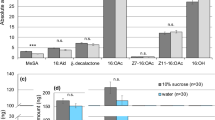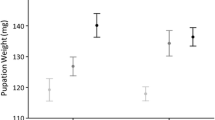Abstract
Hydroxydanaidal, the corematal courtship pheromone of maleUtetheisa ornatrix, shows pronounced quantitative variation in natural populations of the moth. Males that, as larvae, fed on seed-bearing rather than immature food plants (Crotalaria spectabilis orC. mucronata) produce higher levels of hydroxydanaidal. Such males also have higher systemic loads of pyrrolizidine alkaloid, the known metabolic precursor of hydroxydanaidal, whichUtetheisa sequester from their larval diet and which is concentrated in the seeds ofCrotalaria. Males raised on seed-bearing plants also achieve higher adult weight. In the context of sexual selection, therefore, femaleUtetheisa could, through assessment of male hydroxydanaidal levels, gauge both the alkaloid content and body weight of their suitors.
Similar content being viewed by others
References
Adams, R., andRogers, E.F. 1939. The structure of monocrotaline, the alkaloid inCrotalaria spectabilis andCrotalaria retusa.J. Am. Chem. Soc. 61:2815–2819.
Bull, L.B., Culvenor, C.C.J., andDick, A.T. 1968. The Pyrrolizidine Alkaloids. North-Holland, Amsterdam.
Conner, W.E., Eisner, T., Vander Meer, R.K., Guerrero, A., andMeinwald, J. 1981. Precopulatory sexual interaction in an arctiid moth (Utetheisa ornatrix): Role of a pheromone derived from dietary alkaloids.Behav. Ecol. Sociobiol. 9:227–235.
Dussourd, D.E. 1986. Adaptations of insect herbivores to plant defenses. PhD thesis. Cornell University, Ithaca, New York.
Dussourd, D.E., Ubik, K., Harvis, C., Resch, J., Meinwald, J., andEisner, T. 1988. Biparental defense endowment of eggs with acquired plant alkaloid in a moth (Utetheisa ornatrix).Proc. Natl. Acad. Sci. U.S.A. 85:5992–5996.
Eisner, T. 1980. Chemistry, defense, and survival: Case studies and selected topics, pp. 847–878,in M. Locke and D.S. Smith (eds.). Insect Biology in the Future. Academic Press, New York.
Eisner, T., andMeinwald, J. 1987. Alkaloid-derived pheromones and sexual selection in Lepidoptera, pp. 251–269,in G.D. Prestwich and G.J. Bloomquist (eds.). Pheromone Biochemistry. Academic Press, Orlando, Florida.
Grant, A.J., O'Connell, R.J., andEisner, T. 1989. Pheromone-mediated sexual selection in the mothUtetheisa ornatrix: Identification and response properties of olfactory receptor neurons responsive to a male-produced pheromone.J. Insect Behav. 2:371–385.
Johnson, A.E., Molyneux, R.J., andMerrill, G.B. 1985. Chemistry of toxic range plants. Variation in pyrrolizidine alkaloid content ofSenecio, Amsickia, andCrotalaria species.J. Agric. Food Chem. 33:50–55.
Mattocks, A.R. 1986. Chemistry and Toxicology of Pyrrolizidine Alkaloids. Academic Press, New York.
Phelan, P.L., andBaker, T.C. 1986. Male-size-related courtship success and intersexual selection in the tobacco moth,Ephestia elutella.Experientia 42:1291–1293.
Sawhney, R.S., Girotra, R.N., Atal, C.K., Culvenor, C.C.J., andSmith, L.W. 1967. Phytochemical studies on genusCrotalaria: Part VII—Major alkaloids ofC. mucronata, C. brevifolia, andC. laburnifolia.Indian J. Chem. 5:655–656.
Sharma, R.K., Kasture, A.V., Kapoor, K.K., andAtal, C.K. 1965. Phytochemical investigation of the genusCrotalaria. Part V. Occurrence of tertiary bases and theirN-oxides in IndianCrotalaria.Lloydia 28:209–211.
Williams, M.C., andMolyneux, R.J. 1987. Occurrence, concentration, and toxicity of pyrrolizidine alkaloids inCrotalaria seeds.Weed Sci. 35:476–481.
Author information
Authors and Affiliations
Rights and permissions
About this article
Cite this article
Conner, W.E., Roach, B., Benedict, E. et al. Courtship pheromone production and body size as correlates of larval diet in males of the arctiid moth,Utetheisa ornatrix . J Chem Ecol 16, 543–552 (1990). https://doi.org/10.1007/BF01021785
Received:
Accepted:
Issue Date:
DOI: https://doi.org/10.1007/BF01021785




